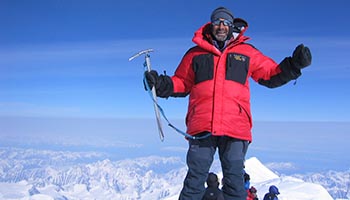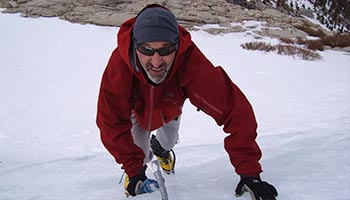HOW CAN WE HELP YOU? Call 1-800-TRY-CHOP
In This Section
Above the Clouds at 20,000 Feet

Mountaineer, Akiva Cohen, PhD, is all smiles after reaching the summit of Denali, 2006.
mccannn [at] email.chop.edu (By Nancy McCann)
Editor’s note: As Labor Day approaches and the summer of 2020 comes to a close, our seasonal “Off Campus” blog series also is wrapping up. It will return next summer with more stories of the passions and exploits of our Research Institute employees. In the meantime, the Research Creative Services writers want to hear from you. Do you know of someone with an unusual hobby or interest in your department or lab? Perhaps it’s you! If so, researchcomm [at] email.chop.edu (send us an email). Maybe you’ll be our next “Off Campus” celebrity.
Akiva Cohen, PhD, physiologist and neuroscientist at Children’s Hospital of Philadelphia, spends his days researching how mild traumatic brain injury alters the brain circuitry that contributes to cognitive and memory problems often associated with concussion. However, when he steps outside Cohen Lab, he likes to put his head in the clouds — literally.
As a lifelong lover of mountains, whether snow covered or desert, Dr. Cohen always has felt a pull toward their steep terrain. He’s climbed some of the tallest, including volcanoes in Ecuador and Mts. Whitney, Rainier, and Denali, the highest peak in North America at 20,310 feet.

Akiva Cohen, PhD, climbing an ice wall on Mt. Whitney.
The outdoors was an integral part of his upbringing, as he grew up hiking, backpacking, and camping with his family. His first climb, at age 9, was to the granite peak of Mt. Sinai for a view of the sunrise. It’s been a challenge keeping his feet at sea level, ever since. He’s climbed Mt. Rainier three times, including a 10-day winter stay at an elevation of 10,000 feet, where he learned how to take care of himself and his teammates in adverse conditions including avalanche rescue and building igloos.
Physically Fit
For Dr. Cohen, who is also on faculty at the Perelman School of Medicine at the University of Pennsylvania, one of the attractions to mountaineering is the hard physical labor. A self- proclaimed gym rat in pre-COVID days, he would go to University of Pennsylvania’s health and fitness center to work out on the elliptical, treadmill, and Stairmaster machines, as well as run the stadium stairs in Franklin Field to get his legs in shape for challenging climbs. By swimming laps, he strengthened his upper body in anticipation of the heavy load he would carry on his back. Carrying a pack is labor intensive, Dr. Cohen said, especially for someone who is 5’8” tall and relatively skinny.
“The first two days on Denali entailed walking along the glacier carrying an 80 pound pack and hauling a 40 pound sled — before the ascent even began,” Dr. Cohen said. “That was just horrifically terrible for a guy like me. After the first two days, no matter how fit you are, it’s just really hard.”
Tis the Season for Safety
The climbing season is usually late spring to summer, when the temperatures average about 10 degrees Fahrenheit, making for the best conditions — but not always. On one climbing trip to Rainier, Dr. Cohen didn’t reach the summit because the snow was hard, which means the top of it was soft.
“Every time you took a step, you would sink up to your hips in the snow,” he said. “It’s called post holing. And it was very, very difficult. We got to about 12,000 feet, and we knew it was going to take a lot longer to get to the peak. We just decided that it was time to turn around and get back home. Sometimes that’s what you have to do.”
Each mountain has its own rules and ways, but safety always comes first in regards to climbing. Take Denali, for instance; climbers must first get permission from the Wildlife Conservation Group, which limits the number of people, the number of trips, and monitors the groups on the mountain. Nevertheless, at advance base camp, there are lots of tents and friendly people exchanging stories and trading things back and forth — almost like a small city.
“It’s just so manic and so big,” Dr. Cohen said. “It’s amusing when you land on the glacier for the first time, and you sit there as the plane takes off, and you think, ‘What in God’s name am I doing?’ Then you realize you’re the newbie on the mountain. You start going through your gear and thinking, ‘Do I really need this? Did I take enough stuff? Do I have enough food?’
“I witnessed this whole process, full circle, when I was on the mountain for 17 days to get to the top and back. Unshaven and unbathed, I was a grizzled vet by the time I got back to camp. I saw all these newbies showing up, and I was thinking, ‘Should I go out there and tell them what they need to bring?’ But I let them figure it on their own, like I did. It’s part of the process.”
The Best Part?
The lifelong friendships he’s developed with his fellow climbers is the best part of mountain climbing, Dr. Cohen said, “and nothing beats the views from above the clouds.”
As for future climbs, Mt. Hood and the Alps are on his list.
“But right now we’re stuck in COVID, so I’m not going anywhere,” Dr. Cohen said, “but I always walk around, and as I look up into the sky, I think about what it would be like to get back up there.”


